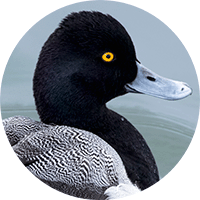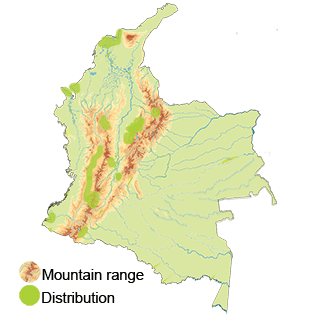Lesser Scaup
Appearance: The Lesser Scaup (42 cm - 16.5 inches) shows both ends of its body black. Its sides have white plumage. Pale gray feathers on top. Dark brown head to breast. White at the base of its grayish bill. It does not have eye ring. Dark gray legs. Females are dark brown head to breast and no eye ring.
Habitat: Lesser Scaup Ducks are commonly observed in freshwater or brackish wetlands such as lakes, reservoirs, lagoons, and marshes. They occur in coastal areas, estuaries, and other shallow water bodies with suitable habitat and food resources.
Behavior: Similar to their behavior in other parts of their range, Lesser Scaup Ducks are diving ducks that spend a significant amount of time underwater. They forage mainly on aquatic plants, seeds, and invertebrates, diving and swimming to access their prey. They often gather in flocks, sometimes in large numbers, and engage in synchronized diving and feeding behaviors.
Breeding: While Lesser Scaup Ducks do not breed in Colombia, they nest in different parts of North America, primarily in the northern United States and parts of Canada. They migrate to Colombia and other regions of Central and South America for the winter season.
Conservation:
Distribution
The Lesser Scaup Duck has a limited distribution in Colombia as it primarily occurs in the country during the winter months as a migratory species. Here is some information about their distribution in Colombia:
Wintering Range: During the non-breeding season, Lesser Scaup Ducks can be found in various wetland habitats in Colombia. They typically migrate from their breeding grounds in North America to seek more favorable conditions and food resources. The specific wintering range of Lesser Scaup Ducks in Colombia is primarily concentrated in certain regions known to offer suitable habitat.
Wetland Habitats: In Colombia, Lesser Scaup Ducks can be observed in wetlands such as lakes, reservoirs, lagoons, marshes, estuaries, and coastal areas. These wetlands provide the necessary food resources and shelter for the ducks during the winter months. It is important to note that the distribution and abundance of Lesser Scaup Ducks within these wetlands may vary from year to year, depending on various factors such as food availability, water levels, and habitat conditions.
Geographical Range: The specific geographical range of Lesser Scaup Ducks in Colombia can vary, but they can be found in different regions across the country. Some known wetland areas where Lesser Scaup Ducks have been observed during the winter include the Caribbean coast, the Cauca River basin, the Magdalena River basin, and other suitable wetland habitats scattered throughout the country.
Sightings and Monitoring: Recording and monitoring the distribution and abundance of Lesser Scaup Ducks in Colombia is an ongoing effort by birdwatchers, ornithologists, and conservation organizations. Their presence and movements are often documented through bird surveys, citizen science initiatives, and scientific research projects that aim to understand their ecology and promote their conservation.
Taxonomy
- Kingdom: Animalia (Animals)
- Phylum: Chordata (Chordates)
- Class: Aves (Birds)
- Order: Anseriformes (Waterfowl)
- Family: Anatidae (Ducks, Geese, and Swans)
- Genus: Aythya
- Species: Aythya affinis
Vocalization
Quacks: The quack is the most well-known vocalization of the Lesser Scaup Duck. It is a short, hoarse, and often nasal call that can sound like "quaark" or "quaa." Male Lesser Scaup Ducks typically produce a series of quacks during courtship displays or to communicate with nearby individuals.
Grunts: Along with quacks, Lesser Scaup Ducks can also emit soft, low-pitched grunting sounds. These grunts are often heard during aggressive encounters or when they are disturbed or alarmed. The grunting vocalization is typically deeper and less frequent compared to the quacks.
Whistles: On occasion, Lesser Scaup Ducks may produce whistling calls, although these are less common. The whistle can sound like a high-pitched "whee-oo" or "whee-eet" sound. Whistling calls are more often associated with alarm or agitation.
Mating Calls: During the breeding season, male Lesser Scaup Ducks may produce specific calls to attract females. These calls can vary in pitch and duration but often consist of a series of quacks and grunts, sometimes combined with head bobbing or other courtship displays.











